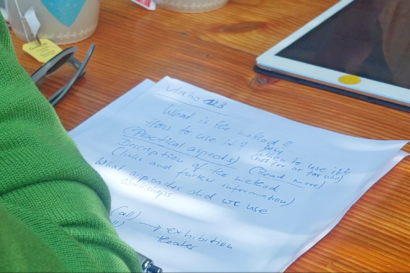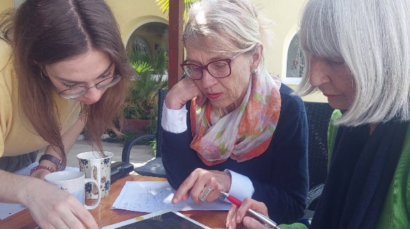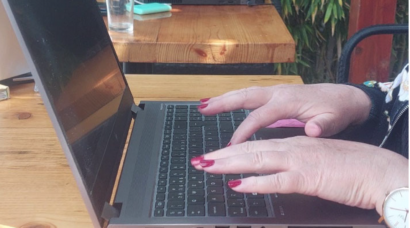PRACTICE | IMPLEMENTATION | POTENTIAL | TOPICS | TOOLS | BOOKS
The analysis of textbooks from a transnational perspective can be seen as an indicator of the extent to which narrow national historical narratives in a society are broken down in favour of a transnational perspective.
The method works with discourse-analytical tools from applied linguistics. It examines whether and in what context certain topics are dealt with and how they are conveyed: Who talks about whom and in what way? Which social groups are portrayed in an active and which in a passive role? To what extent are opinions and ideologies – explicit or implicit – also transported in the texts? Do the texts contain stereotypes or generalisations when “own” or “other” positions are described? Which perspectives are missing from the texts?
The analysis does not only refer to the textbook texts, it also includes the illustrations. In the picture analysis, the choice of illustrations and the corresponding captions are examined. To what extent is the reading of the pictures influenced by the captions? Do the texts and illustrations support each other in their statements or do they convey contradictory messages?
Similar questions arise in relation to the didactic tasks. Do the exercises encourage learners to question stereotypes or adopt different perspectives?
An international comparison of textbooks can show different perspectives on the same historical events and developments. Especially in border areas, where there is often a mixing of population groups, cross-border historical events can be perceived differently.
PRACTICE
How to analyse textbooks under a transnational perspective
Choose a general topic such as “ethnic minorities”, “refugees”, “colonialism”. Then pick out concrete historical events that relate to the topic. Make a selection of different textbooks that cover the issue. Find the relevant passages in the textbooks and analyse the texts in the way described above.
 The results should be recorded in a separate ANALYSIS SHEET for each textbook. In this way, the findings can be summarised and compared in a matrix. Even if the selected event does not occur in a history textbook, this can be counted as a statement.
The results should be recorded in a separate ANALYSIS SHEET for each textbook. In this way, the findings can be summarised and compared in a matrix. Even if the selected event does not occur in a history textbook, this can be counted as a statement.
The results of the analysis can then be reflected on in a group discussion. In doing so, the participants learn to critically question the teaching materials and develop a sensitivity for transnational and multi-perspective approaches to historical topics.
Implementation and experiences in the project
As a method to look back on and to reappraise historical events, the project team analysed and compared history textbooks from seven European countries currently used in the classroom. In each partner country several textbooks at high school level were examined. In some countries, like e.g. Belgium, printed history textbooks are not the only source of teaching materials for history lessons. Teachers there can choose from a pool of teaching materials from an official school internet platform. Since the teachers design the lessons very individually (within the official teaching goals of the school curricula), it is more difficult to get a general inside to what extent the pupils are confronted with / made aware of transnational and multi-perspective approaches in the teaching of history. However, even in countries where mainly textbooks are in use, teachers can choose among several textbooks. Therefore, the analysis has to take into account by which team of authors a textbook was written and which publisher it was published. Both forms offer different possibilities and pose different challenges for teachers. In textbooks, history is often presented in form of a chronology.
| The pool of internet materials leaves it up to the teacher to establish historical connections according to his or her own priorities. Lessons can be geared to the composition and interests of the students and thus pay more attention to some historical events. On the other hand, textbooks can rather ensure that a certain canon of historical events and developments are seen in their (not only) chronological context and that they are covered in class. Particular attention was paid to whether narrative about selected historic events were presented form different national and social perspectives. If a chosen topic was too specific we looked for a related issue in a wider context. Even the absence of a topic was to be seen as a result with regard to the assumed national and social relevance of the topic from the perspective of the editor. (See Historical Topics) One result of our analysis was that there are hardly any transnational and multi-perspective approaches to teaching history in the teaching materials themselves. And even if global phenomena such as colonialism and migration are found as topics in the textbooks, they are mainly not presented from a transnational perspective. Only in exceptional cases are historical events told from the perspective of different social groups. |
Potential of the method for transnational and multi-perspective approaches
The history textbooks currently used in schools or teaching materials on internet platforms reflect those historical narratives that seem to be of interest for educational policy at a particular time. Therefore, the analysis of textbooks / teaching materials is also of interest outside the school context.
 Against the background of national movements regaining strength in the European context and the increasingly diverse societies in terms of ethnic and national affiliations, the critical questioning of national historical perspectives is of particular importance. Text and image analysis generally sharpens the view of how historical events are conveyed in different contexts and media (newspapers, television, internet, advertising, political speeches). The knowledge of explicitly and implicitly transported messages sensitises the learning groups in everyday life for too narrow national narratives, enemy images and clichés. Source criticism is an essential prerequisite for being able to reflect and criticise fake news or hate messages with regard to ethnic and national minorities, especially on the internet and social media. Awakening interest in the views of others opens up a broader horizon and promotes the questioning of (one’s own) inflexible opinions.
Against the background of national movements regaining strength in the European context and the increasingly diverse societies in terms of ethnic and national affiliations, the critical questioning of national historical perspectives is of particular importance. Text and image analysis generally sharpens the view of how historical events are conveyed in different contexts and media (newspapers, television, internet, advertising, political speeches). The knowledge of explicitly and implicitly transported messages sensitises the learning groups in everyday life for too narrow national narratives, enemy images and clichés. Source criticism is an essential prerequisite for being able to reflect and criticise fake news or hate messages with regard to ethnic and national minorities, especially on the internet and social media. Awakening interest in the views of others opens up a broader horizon and promotes the questioning of (one’s own) inflexible opinions.
Textbook analysis should encourage the learning group to critically question recognised authorities such as teachers, but also other “self-appointed experts” again and again. The findings of the textbook analysis can encourage learning groups to try out the methods carried out in the project “Transnational History”.
There are some initiatives between neighbouring countries to produce textbooks with focus on their specific relationship. In most cases, these are countries that have a conflictual relationship, like Germany and Poland or Austria und Czech Republic.
 More detailed information on the method of textbook analysis can be provided e.g. by studies on international history research conducted by the Georg Eckert Institute for International History Research, which carries out thematic studies in textbooks in a country comparison but also textbook analyses for a selected country. http://www.gei.de/en/home.html
More detailed information on the method of textbook analysis can be provided e.g. by studies on international history research conducted by the Georg Eckert Institute for International History Research, which carries out thematic studies in textbooks in a country comparison but also textbook analyses for a selected country. http://www.gei.de/en/home.html
HISTORICAL TOPICS
THE SLOVENE MINORITY IN AUSTRIA, Autochthonous Minorities, Austria
DECOLONISATION: FROM BELGIAN CONGO TO BRUSSELS, Decolonisation, Belgium (1)
EU AND HISTORY, Belgium (2)
FLIGHT AND EXPULSION, Germany
KONAVLE REGION IN SECOND WORLD WAR, Croatian history in WWII, Croatia
ANTISEMITISM IN MARCH 1968 IN POLAND AND MASS EMIGRATION OF POLES OF JEWISH ORIGIN 1968 – 1972, Antisemitism after WWII, Poland
THE ROMANIAN REVOLUTION, Revolutions in Eastern Europe 1989/90, Romania
MIGRATION TO SWEDEN, EU-internal migration, Sweden
Tools / Downloads
ANALYSIS SHEET – The exemplarily Analysis Sheet that we used in the  Transnational History project.
Transnational History project.
BEST PRACTISE BOOK – Have a look at our best practice book we could find for our topic Anti-semitism after World War II. One of the listed books elaborates a multi-perspective approach.
DOWNLOAD THE TEMPLATE – The Template might be adapted for your own use.
List of reviewed schoolbooks
AUSTRIA | BELGIUM | CROATIA | GERMANY | POLAND | ROMANIA | SWEDEN
Austria
- Scheipl, Josef; Scheucher, Alois; Ebenhoch, Ulrike; Staudinger, Eduard: Zeitbilder, 7. Schülerbuch. Geschichte und Sozialkunde. Politische Bildung. Vom Ende des Ersten Weltkriegs bis in die Gegenwart, Wien, Österreichischer Bundesverlag, 2019
- Scheipl, Josef; Scheucher, Alois; Ebenhoch, Ulrike; Staudinger, Eduard: Zeitbilder, 7/8. Schülerbuch. Geschichte und Sozialkunde. Politische Bildung. Vom Ende des Ersten Weltkriegs bis in die Gegenwart, Wien, Österreichischer Bundesverlag, 2019
- Pokorny, Hans; Pokorny, Renate, Lemberger, Michael: Netzwerk Geschichte 7. Geschichte und Sozialkunde/Politische Bildung. Lehr- und Arbeitsbuch für die 7. Klasse AHS, für die 3. Klasse BASOP und BAKIP mit Weiterverwendung in der 5. Klasse. Politische Bildung online. Bildungsverlag Lemberger, 2013 (2. Auflage)
- Mader, Sabine; Strutz, Andrea; u.a.: querdenken – Geschichte und Politische Bildung 4, approbiert für Mittelschule, Geschichte und Sozialkunde/Politische Bildung, 4. Klasse, AHS-Unterstufe, Geschichte und Sozialkunde/Politische Bildung, 4. Klasse. Österreichischer Bundesverlag, 2019. Querdenken 4 online
- Graf, Margot; Halbbartschlager, Franz; Vogel-Waldhütter; Martina: MEHRfach Geschichte. 4. Klasse, Teil 1. Wissen und Verstehen. Veritas, 2020 (5. Auflage)
Belgium
- Book title or internet url: Een geschiedenis van België, Authors: Gita Demeckere, Bruno De Wever, Tom De Paepe, m.m.v. Guy Vanthemsche, Year of publication: 2021 (first print 2012), Publisher: Academia Press
- Book title or internet url: La grande histoire de la Belgique, Author: Patrick Wever, Year of publication: 2016 (first print 2013), Publisher: – tempus, editions perrin
- Construire l’Histoire – 6e année – Un monde en mutation (de 1919 à nos jours), Authors: Sous la direction de Jean-Louis Jadonelle & Jean Georges, Year of publication: Publisher: Éditions Érasme
- Le portail de l’enseignement en Fédération Wallonie-Bruxelles
- Moroccan Migration in Belgium: More than 50 Years of Settlement, Series: CeMIS Migration and Intercultural Studies, Volume: 1, Authors: Christiane Timmerman, Nadia Fadil, Idesbald Goddeeris, Noel Clycq, Karim Ettourki, Year of publication: 2017
- Construire l’Histoire – 6e année – Un monde en mutation (de 1919 à nos jours), Authors: Sous la direction de Jean-Louis Jadonelle & Jean Georges, Publisher: Éditions Érasme
- First version European School Education Platform, (This platform will be available in the coming months The full content of both eTwinning and School Education Gateway remain temporarily online).
- BELGIUMS WWII – platform – found at: Link to the general school education resource on the internet (BE/ French speaking part): Le portail de l’enseignement en Fédération Wallonie-Bruxelles, Authors: various (for the platform in general); https://www.cegesoma.be/ for the WWII-website, Year of publication: This is an internet-based education platform with all kinds of resources. 2017ff., Publisher: CegeSoma
- Citoyen du monde – L’Histoire du nos migrants – Dossier pedagogique, Authors: Myria, Year of publication: 2017, Publisher: Myria
- Profiel en traject van de werkzoekenden in het Brussels hoofdstedelijk gewest monitoring volges origine Juni 2019, Authors: view.brussels / Brussels observatorium voor werk en opleiding, Year of publication:2019, Publisher: Brussels observatorium voor werk en opleiding
- Die “letzten Belgier” sprechen Deutsch, Manifestationen kollektiver Identität in den belgischen Ostkantonen – ein Forschungstagebuch – online research diary, Authors: Oliver Zöllner, Year of publication: First deposited: 18 March 2012. Last modified: 2 Jan 2018.
Croatia
- POVIJEST 8 – udžbenik za 8. razred osnovne škole, Stjepan Bekavac, Mario Jareb; Nakladnik: ALFA
- VREMEPLOV 8 – udžbenik povijesti za osmi razred osnovne škole, Vesna Đurić; Nakladnik: PROFIL
- POVIJEST 8 – udžbenik povijesti za osmi razred osnovne škole, Snježana Koren; Nakladnik: PROFIL
- TRAGOM PROŠLOSTI 8 – udžbenik povijesti s višemedijskim nastavnim materijalima u osmom razredu osnovne škole, Krešimir Erdelja, Igor Stojaković; Nakladnik: Školska knjiga
Germany
- Buchners Kolleg Geschichte 11, Unterrichtswerk für die gymnasiale Oberstufe, Neue Ausgabe Baden-Württemberg, Bamberg 2014
- Buchners Kolleg Geschichte 12, Unterrichtswerk für die gymnasiale Oberstufe, Neue Ausgabe Baden-Württemberg, Bamberg 2013
- Buchners Kompendium Geschichte, Lehr- und Arbeitsbuch für die Oberstufe, Bamberg 2012
- Geschichte und Geschehen, Jahrgangsstufe 1 und 2, Berufliche Gymnasien, Stuttgart 2017
- Zeit für Geschichte 12, Oberstufe für Baden-Württemberg, Stuttgart 2010
- Lehrplan für Geschichte für das berufliche Gymnasium, Amtsblatt des Ministeriums für Kultus, Jugend und Sport Baden-Württemberg, 30. Juni 2016
Poland
- Tytuł serii: Ślady czasu, Pozycja w serii, ¼
- Tytuł: Historia 1. Ślady czasu. Podręcznik dla klasy 1 liceum i technikum. Zakres podstawowy i rozszerzony
- Autor: Łukasz Kępski, Jakub Kufel, Przemysław Ruchlewski
- Wydawnictwo: Gdańskie Wydawnictwo Oświatowe sp. z o.o. sp. K
- Tytuł serii: Historia. Zakres rozszerzony (OPERON), Pozycja w serii, 3/8
- Tytuł: Historia 2. Zakres rozszerzony. Część 1. Podręcznik dla szkół ponadpodstawowych
- Autor: Mirosław Ustrzycki, Janusz Ustrzycki
- Wydawnictwo: Wydawnictwo Pedagogiczne OPERON Sp. z o.o.
- Tytuł serii: Poznać przeszłość, Pozycja w serii, ¾
- Tytuł: Poznać przeszłość 3. Podręcznik do historii dla liceum ogólnokształcącego i technikum. Zakres podstawowy
- Autor: Jarosław Kłaczkow, Anna Łaszkiewicz, Stanisław Roszak
- Wydawnictwo: Nowa Era Spółka z o.o.
- Tytuł serii: Zrozumieć przeszłość. Zakres rozszerzony, Pozycja w serii, 4/4
- Tytuł: Zrozumieć przeszłość 4. Podręcznik do historii dla liceum ogólnokształcącego i technikum. Zakres rozszerzony
- Autor: Robert Śniegocki, Agnieszka Zielińska
- Wydawnictwo: Nowa Era Spółka z o.o.
Romania (elaborated by the Austrian team)
The Romanian Revolution is hardly mentioned in textbooks for highschoolers (14-18 years old). Some barely mention it in the chronology. Some do not mention it at all. It is almost non-existent in text books from primary school and gymnasium. (7-10 years old and 10-14 years old). The fact is that, to this day, it is still a controversial subject, mired in conspiracy theories. It is not celebrated, it is commemorated. A bunch of articles that appeared in Romanian media in 2019 (marking 30 years since the Revolution) discussed this fact, but nothing actually happened after the articles came out.
- Manualul de Istorie pentru Clasa a XII-a, Editura Niculescu, 2017
- Manualul de Istorie, Editura Corint, 2016
- Istorie. Manual pentru clasa a XI-a, Authors: Sorin Oane, Catalin Strat, Year of publication: 2012, Publisher: Humanitas Educational
- Istorie. Manual pentru clasa a XI-a, Authors: Alexandru Barnea, Vasile Manea, Eugen Palade, Florin Petrescu, Bogdan Teodorescu, Year of publication: 2014, Publisher: Corint Educational
- Istorie. Manual pentru clasa a XI-a, Authors: Magda Stan. Cristian Vornicu, Year of publication: 2006, Publisher: Editura Niculescu ABC
Sweden
- Norrköpings historia 1900-talet, red Hans Nilsson, 2000, Centrum för lokalhistoria, (20th century history of Norrköping)
- SOS Historia 7-9, Elisabeth Ivansson, Mattias Tordai, 2019, Liber, (Worldhistory for gymnasium and adult education)
- Perspektiv på historien, 2017, Gleerups, (Worldhistory for gymnasium and adult education)
- Möt historien, 2017, Gleerups, How history effects today´s life, for gymnasium and adult education
- Brytningstider, red Kristina Hultman, 1998, Atlas förlag, (Research about the Industrial lanscape, old textile area, in Norrköping)
- Kulturarv i rörelse, Annika Alzén, 2011, Symposium, (About historical research in an informal non academic contex)
